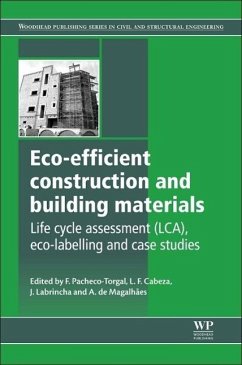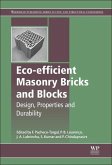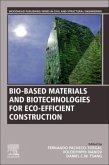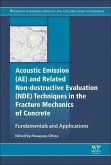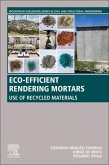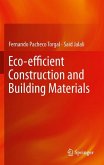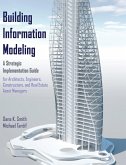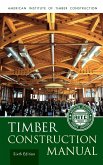Fernando Pacheco-Torgal, Luisa F. Cabeza, Joao Labrincha
Eco-Efficient Construction and Building Materials
Life Cycle Assessment (LCA), Eco-Labelling and Case Studies
Fernando Pacheco-Torgal, Luisa F. Cabeza, Joao Labrincha
Eco-Efficient Construction and Building Materials
Life Cycle Assessment (LCA), Eco-Labelling and Case Studies
- Gebundenes Buch
- Merkliste
- Auf die Merkliste
- Bewerten Bewerten
- Teilen
- Produkt teilen
- Produkterinnerung
- Produkterinnerung
Eco-efficient Construction and Building Materials reviews ways of assessing the environmental impact of construction and building materials. Part one discusses the application of life cycle assessment (LCA) methodology to building materials as well as eco-labeling. Part two includes case studies showing the application of LCA methodology to different types of building material, from cement and concrete to wood and adhesives used in building. Part three includes case studies applying LCA methodology to particular structures and components.
Andere Kunden interessierten sich auch für
![Eco-Efficient Masonry Bricks and Blocks Eco-Efficient Masonry Bricks and Blocks]() Eco-Efficient Masonry Bricks and Blocks182,99 €
Eco-Efficient Masonry Bricks and Blocks182,99 €![Bio-based Materials and Biotechnologies for Eco-efficient Construction Bio-based Materials and Biotechnologies for Eco-efficient Construction]() Bio-based Materials and Biotechnologies for Eco-efficient Construction178,99 €
Bio-based Materials and Biotechnologies for Eco-efficient Construction178,99 €![Acoustic Emission and Related Non-Destructive Evaluation Techniques in the Fracture Mechanics of Concrete Acoustic Emission and Related Non-Destructive Evaluation Techniques in the Fracture Mechanics of Concrete]() Acoustic Emission and Related Non-Destructive Evaluation Techniques in the Fracture Mechanics of Concrete156,99 €
Acoustic Emission and Related Non-Destructive Evaluation Techniques in the Fracture Mechanics of Concrete156,99 €![Eco-efficient Rendering Mortars Eco-efficient Rendering Mortars]() Catarina Brazao FarinhaEco-efficient Rendering Mortars100,99 €
Catarina Brazao FarinhaEco-efficient Rendering Mortars100,99 €![Eco-efficient Construction and Building Materials Eco-efficient Construction and Building Materials]() Fernando Pacheco TorgalEco-efficient Construction and Building Materials113,99 €
Fernando Pacheco TorgalEco-efficient Construction and Building Materials113,99 €![Building Information Modeling Building Information Modeling]() Dana K SmithBuilding Information Modeling84,99 €
Dana K SmithBuilding Information Modeling84,99 €![AITC Timber Construction Manua AITC Timber Construction Manua]() American Institute of Timber Construction (Aitc)AITC Timber Construction Manua132,99 €
American Institute of Timber Construction (Aitc)AITC Timber Construction Manua132,99 €-
-
-
Eco-efficient Construction and Building Materials reviews ways of assessing the environmental impact of construction and building materials. Part one discusses the application of life cycle assessment (LCA) methodology to building materials as well as eco-labeling. Part two includes case studies showing the application of LCA methodology to different types of building material, from cement and concrete to wood and adhesives used in building. Part three includes case studies applying LCA methodology to particular structures and components.
Produktdetails
- Produktdetails
- Woodhead Publishing Series in Civil and Structural Engineering
- Verlag: Elsevier Science & Technology / Woodhead Publishing
- Artikelnr. des Verlages: C2013-0-16358-1
- Seitenzahl: 624
- Erscheinungstermin: 31. Dezember 2013
- Englisch
- Abmessung: 241mm x 154mm x 43mm
- Gewicht: 1070g
- ISBN-13: 9780857097675
- ISBN-10: 0857097679
- Artikelnr.: 38053641
- Herstellerkennzeichnung
- Libri GmbH
- Europaallee 1
- 36244 Bad Hersfeld
- gpsr@libri.de
- Woodhead Publishing Series in Civil and Structural Engineering
- Verlag: Elsevier Science & Technology / Woodhead Publishing
- Artikelnr. des Verlages: C2013-0-16358-1
- Seitenzahl: 624
- Erscheinungstermin: 31. Dezember 2013
- Englisch
- Abmessung: 241mm x 154mm x 43mm
- Gewicht: 1070g
- ISBN-13: 9780857097675
- ISBN-10: 0857097679
- Artikelnr.: 38053641
- Herstellerkennzeichnung
- Libri GmbH
- Europaallee 1
- 36244 Bad Hersfeld
- gpsr@libri.de
Fernando Pacheco Torgal is a Principal Investigator at C-TAC, University of Minho. He holds the title of Counsellor (Top 0.5%) from the Portuguese Engineers Association and has been consistently recognized as a Scopus Highly Cited Scientist in the global rankings by Stanford University. With over 300 publications to his name, he has carried out in-depth peer reviews of more than one thousand scientific papers and assessed nearly one hundred research grant proposals across 15 countries. He serves on the editorial boards of nine international journals and has been involved in editorial decisions for several hundred manuscripts. In addition, he has edited 33 international books, many of which are available in the libraries of prestigious institutions such as Harvard, MIT, and Stanford.
- Contributor contact details
- Woodhead Publishing Series in Civil and Structural Engineering
- 1: Introduction to the environmental impact of construction and building materials
- Abstract
- 1.1 Introduction
- 1.2 Environmental impact assessment
- 1.3 The European Construction Products Regulation (CPR)
- 1.4 Outline of the book
- Part I: Life cycle assessment (LCA), eco-labelling and procurement
- 2: Mineral resource depletion assessment
- Abstract
- 2.1 Introduction
- 2.2 Definition and classification of mineral resources
- 2.3 Trends in mineral use and depletion
- 2.4 Dynamic analysis of mineral resource use and depletion: the Hubbert peak model
- 2.5 From grave to cradle: A new approach to assess and account for mineral depletion
- 2.6 Conclusions
- 3: Life cycle assessment (LCA) of sustainable building materials: an overview
- Abstract
- 3.1 Introduction
- 3.2 The environmental impact of building materials
- 3.3 Life cycle assessment (LCA) and sustainable building materials
- 3.4 Conclusions
- 4: Life cycle assessment (LCA) of the building sector: strengths and weaknesses
- Abstract
- 4.1 Introduction
- 4.2 The overall strengths and limitations of life cycle assessment (LCA)
- 4.3 Strengths and weaknesses within LCA methodology
- 4.4 Conclusions
- 5: Using life cycle assessment (LCA) methodology to develop eco-labels for construction and building materials
- Abstract
- 5.1 Introduction: life cycle thinking and eco-labels
- 5.2 Life cycle assessment (LCA)
- 5.3 Types of eco-labels and their relation to LCA
- 5.4 Environmental certification programmes for buildings
- 5.5 Future trends
- 5.6 Sources of further information and advice
- 6: The EU Ecolabel scheme and its application to construction and building materials
- Abstract
- 6.1 Introduction
- 6.2 The EU Ecolabel and the European Commission policy for sustainability
- 6.3 History and goals of the EU Ecolabel scheme
- 6.4 EU Ecolabel establishment procedures and criteria
- 6.5 EU Ecolabel and green public procurement (GPP)
- 6.6 EU Ecolabel and national ecolabelling schemes
- 6.7 EU Ecolabel for eco-efficient construction and building materials
- 6.8 Future trends
- 6.9 Sources of further information and advice
- 6.11 Appendix: abbreviations
- 7: Environmental product declaration (EPD) labelling of construction and building materials
- Abstract
- 7.1 Introduction
- 7.2 Regulatory framework
- 7.3 Objectives and general principles
- 7.4 Environmental product declaration (EPD) methodology
- 7.5 EPD programmes around the world
- 7.6 Product category rules (PCR) for construction and building materials
- 7.7 Case studies: EPD for construction and building materials
- 7.8 Conclusions
- 8: Shortcomings of eco-labelling of construction and building materials
- Abstract
- 8.1 Introduction
- 8.2 Typical shortcomings of eco-labels
- 8.3 Building materials
- 8.4 Eco-labelling of buildings
- 8.5 Conclusions
- 9: Green public procurement (GPP) of construction and building materials
- Abstract
- 9.1 Introduction
- 9.2 Green public procurement (GPP) and sustainable public procurement (SPP) as policy instruments
- 9.3 Policy context in the EU
- 9.4 Policy context in selected countries
- 9.5 The need for a paradigm shift
- 9.6 Implementing GPP/SPP in the construction sector
- 9.7 Key concerns for progress towards SPP
- 2: Mineral resource depletion assessment
- Part II: Assessing the environmental impact of construction and building materials
- 10: A
- Contributor contact details
- Woodhead Publishing Series in Civil and Structural Engineering
- 1: Introduction to the environmental impact of construction and building materials
- Abstract
- 1.1 Introduction
- 1.2 Environmental impact assessment
- 1.3 The European Construction Products Regulation (CPR)
- 1.4 Outline of the book
- Part I: Life cycle assessment (LCA), eco-labelling and procurement
- 2: Mineral resource depletion assessment
- Abstract
- 2.1 Introduction
- 2.2 Definition and classification of mineral resources
- 2.3 Trends in mineral use and depletion
- 2.4 Dynamic analysis of mineral resource use and depletion: the Hubbert peak model
- 2.5 From grave to cradle: A new approach to assess and account for mineral depletion
- 2.6 Conclusions
- 3: Life cycle assessment (LCA) of sustainable building materials: an overview
- Abstract
- 3.1 Introduction
- 3.2 The environmental impact of building materials
- 3.3 Life cycle assessment (LCA) and sustainable building materials
- 3.4 Conclusions
- 4: Life cycle assessment (LCA) of the building sector: strengths and weaknesses
- Abstract
- 4.1 Introduction
- 4.2 The overall strengths and limitations of life cycle assessment (LCA)
- 4.3 Strengths and weaknesses within LCA methodology
- 4.4 Conclusions
- 5: Using life cycle assessment (LCA) methodology to develop eco-labels for construction and building materials
- Abstract
- 5.1 Introduction: life cycle thinking and eco-labels
- 5.2 Life cycle assessment (LCA)
- 5.3 Types of eco-labels and their relation to LCA
- 5.4 Environmental certification programmes for buildings
- 5.5 Future trends
- 5.6 Sources of further information and advice
- 6: The EU Ecolabel scheme and its application to construction and building materials
- Abstract
- 6.1 Introduction
- 6.2 The EU Ecolabel and the European Commission policy for sustainability
- 6.3 History and goals of the EU Ecolabel scheme
- 6.4 EU Ecolabel establishment procedures and criteria
- 6.5 EU Ecolabel and green public procurement (GPP)
- 6.6 EU Ecolabel and national ecolabelling schemes
- 6.7 EU Ecolabel for eco-efficient construction and building materials
- 6.8 Future trends
- 6.9 Sources of further information and advice
- 6.11 Appendix: abbreviations
- 7: Environmental product declaration (EPD) labelling of construction and building materials
- Abstract
- 7.1 Introduction
- 7.2 Regulatory framework
- 7.3 Objectives and general principles
- 7.4 Environmental product declaration (EPD) methodology
- 7.5 EPD programmes around the world
- 7.6 Product category rules (PCR) for construction and building materials
- 7.7 Case studies: EPD for construction and building materials
- 7.8 Conclusions
- 8: Shortcomings of eco-labelling of construction and building materials
- Abstract
- 8.1 Introduction
- 8.2 Typical shortcomings of eco-labels
- 8.3 Building materials
- 8.4 Eco-labelling of buildings
- 8.5 Conclusions
- 9: Green public procurement (GPP) of construction and building materials
- Abstract
- 9.1 Introduction
- 9.2 Green public procurement (GPP) and sustainable public procurement (SPP) as policy instruments
- 9.3 Policy context in the EU
- 9.4 Policy context in selected countries
- 9.5 The need for a paradigm shift
- 9.6 Implementing GPP/SPP in the construction sector
- 9.7 Key concerns for progress towards SPP
- 2: Mineral resource depletion assessment
- Part II: Assessing the environmental impact of construction and building materials
- 10: A

